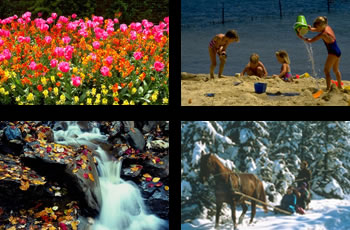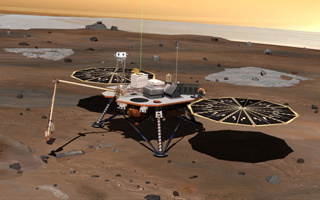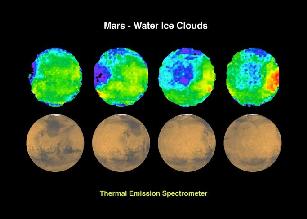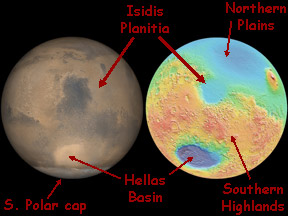Click on image for full size
Images courtesy Phil James (Univ. Toledo), Todd Clancy (Space Science Inst., Boulder, CO), Steve Lee (Univ. Colorado), and NASA [North Pole image]; and NASA, J. Bell (Cornell U.) and M. Wolff (SSI) [South Pole image].
Mars Polar Regions
The North and South Poles on Mars are a lot like the polar regions on Earth. They are the coldest places on the planet. The temperatures in the winter can drop to -150° C (about -238° F). Both poles have ice caps that are mostly made of water ice. The ice caps get bigger and smaller as the seasons on Mars change.
The polar ice caps on Mars have two kinds of ice. They have lots of water ice, like the ice caps on Earth. They also have "dry ice". Dry ice is made of carbon dioxide. Mars has seasons, like Earth. When it is winter at one pole, some carbon dioxide from the atmosphere of Mars freezes, making dry ice. The polar cap on the winter half of Mars get much bigger as dry ice is added to it. When summer comes to that pole, much of the dry ice goes back into the atmosphere. The ice cap gets much smaller in the summer.
Scientists are very interested in the poles of Mars. Life on Earth needs water. Mars doesn't have any liquid water on the surface. But the poles have lots of ice made from water. Was that ice ever liquid water? The water ice might give us clues about life on Mars. We don't know if Mars has life now, or if it ever did in the past. Maybe learning more about water, and water ice, on Mars will help us learn whether there is (or ever was) life on Mars.
A new space mission will land on Mars in May 2008. It is called the Phoenix Mars Lander. It will land near the North Pole on Mars. Phoenix will search for water ice there. Scientists hope it will help us learn about the history of water, and maybe even life, on Mars!















